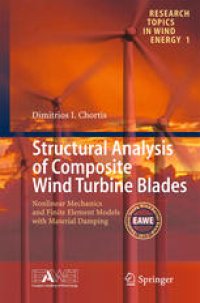
Ebook: Structural Analysis of Composite Wind Turbine Blades: Nonlinear Mechanics and Finite Element Models with Material Damping
Author: Dimitris I Chortis (auth.)
- Genre: Technique // Energy
- Tags: Renewable and Green Energy, Renewable and Green Energy, Complexity
- Series: Research Topics in Wind Energy 1
- Year: 2013
- Publisher: Springer International Publishing
- Edition: 1
- Language: English
- pdf
This book concerns the development of novel finite elements for the structural analysis of composite beams and blades. The introduction of material damping is also an important aspect of composite structures and it is presented here in terms of their static and dynamic behavior. The book thoroughly presents a new shear beam finite element, which entails new blade section mechanics, capable of predicting structural blade coupling due to composite coupling and/or internal section geometry. Theoretical background is further expanded towards the inclusion of nonlinear structural blade models and damping mechanics for composite structures. The models effectively include geometrically nonlinear terms due to large displacements and rotations, improve the modeling accuracy of very large flexible blades, and enable the modeling of rotational stiffening and buckling, as well as, nonlinear structural coupling. Validation simulations on specimen level study the geometric nonlinearities effect on the modal frequencies and damping values of composite strips of various angle-ply laminations under either tensile or buckling loading. A series of correlation cases between numerical predictions and experimental measurements give credence to the developed nonlinear beam finite element models and underline the essential role of new nonlinear damping and stiffness terms.
This book concerns the development of novel finite elements for the structural analysis of composite beams and blades. The introduction of material damping is also an important aspect of composite structures and it is presented here in terms of their static and dynamic behavior. The book thoroughly presents a new shear beam finite element, which entails new blade section mechanics, capable of predicting structural blade coupling due to composite coupling and/or internal section geometry. Theoretical background is further expanded towards the inclusion of nonlinear structural blade models and damping mechanics for composite structures. The models effectively include geometrically nonlinear terms due to large displacements and rotations, improve the modeling accuracy of very large flexible blades, and enable the modeling of rotational stiffening and buckling, as well as, nonlinear structural coupling. Validation simulations on specimen level study the geometric nonlinearities effect on the modal frequencies and damping values of composite strips of various angle-ply laminations under either tensile or buckling loading. A series of correlation cases between numerical predictions and experimental measurements give credence to the developed nonlinear beam finite element models and underline the essential role of new nonlinear damping and stiffness terms.
This book concerns the development of novel finite elements for the structural analysis of composite beams and blades. The introduction of material damping is also an important aspect of composite structures and it is presented here in terms of their static and dynamic behavior. The book thoroughly presents a new shear beam finite element, which entails new blade section mechanics, capable of predicting structural blade coupling due to composite coupling and/or internal section geometry. Theoretical background is further expanded towards the inclusion of nonlinear structural blade models and damping mechanics for composite structures. The models effectively include geometrically nonlinear terms due to large displacements and rotations, improve the modeling accuracy of very large flexible blades, and enable the modeling of rotational stiffening and buckling, as well as, nonlinear structural coupling. Validation simulations on specimen level study the geometric nonlinearities effect on the modal frequencies and damping values of composite strips of various angle-ply laminations under either tensile or buckling loading. A series of correlation cases between numerical predictions and experimental measurements give credence to the developed nonlinear beam finite element models and underline the essential role of new nonlinear damping and stiffness terms.
Content:
Front Matter....Pages 1-10
Introduction....Pages 1-8
Historical Review on the Linear and Nonlinear Damped Structural Behavior of Composite Structures....Pages 9-24
Linear Material Coupling Effect on Structural Damping of Composite Beams and Blades....Pages 25-67
Nonlinear Damping Mechanics and Finite Element Model for the Static and Damped Free-Vibration Analysis of Composite Strips....Pages 69-101
Nonlinear Dynamic Response of Composite Plate-Beams....Pages 103-150
Prediction of Nonlinear Damped Response of Large-Scale Blade Composite Structures....Pages 151-184
Conclusions and Suggestions for Future Research Topics....Pages 185-189
Back Matter....Pages 191-231
This book concerns the development of novel finite elements for the structural analysis of composite beams and blades. The introduction of material damping is also an important aspect of composite structures and it is presented here in terms of their static and dynamic behavior. The book thoroughly presents a new shear beam finite element, which entails new blade section mechanics, capable of predicting structural blade coupling due to composite coupling and/or internal section geometry. Theoretical background is further expanded towards the inclusion of nonlinear structural blade models and damping mechanics for composite structures. The models effectively include geometrically nonlinear terms due to large displacements and rotations, improve the modeling accuracy of very large flexible blades, and enable the modeling of rotational stiffening and buckling, as well as, nonlinear structural coupling. Validation simulations on specimen level study the geometric nonlinearities effect on the modal frequencies and damping values of composite strips of various angle-ply laminations under either tensile or buckling loading. A series of correlation cases between numerical predictions and experimental measurements give credence to the developed nonlinear beam finite element models and underline the essential role of new nonlinear damping and stiffness terms.
Content:
Front Matter....Pages 1-10
Introduction....Pages 1-8
Historical Review on the Linear and Nonlinear Damped Structural Behavior of Composite Structures....Pages 9-24
Linear Material Coupling Effect on Structural Damping of Composite Beams and Blades....Pages 25-67
Nonlinear Damping Mechanics and Finite Element Model for the Static and Damped Free-Vibration Analysis of Composite Strips....Pages 69-101
Nonlinear Dynamic Response of Composite Plate-Beams....Pages 103-150
Prediction of Nonlinear Damped Response of Large-Scale Blade Composite Structures....Pages 151-184
Conclusions and Suggestions for Future Research Topics....Pages 185-189
Back Matter....Pages 191-231
....